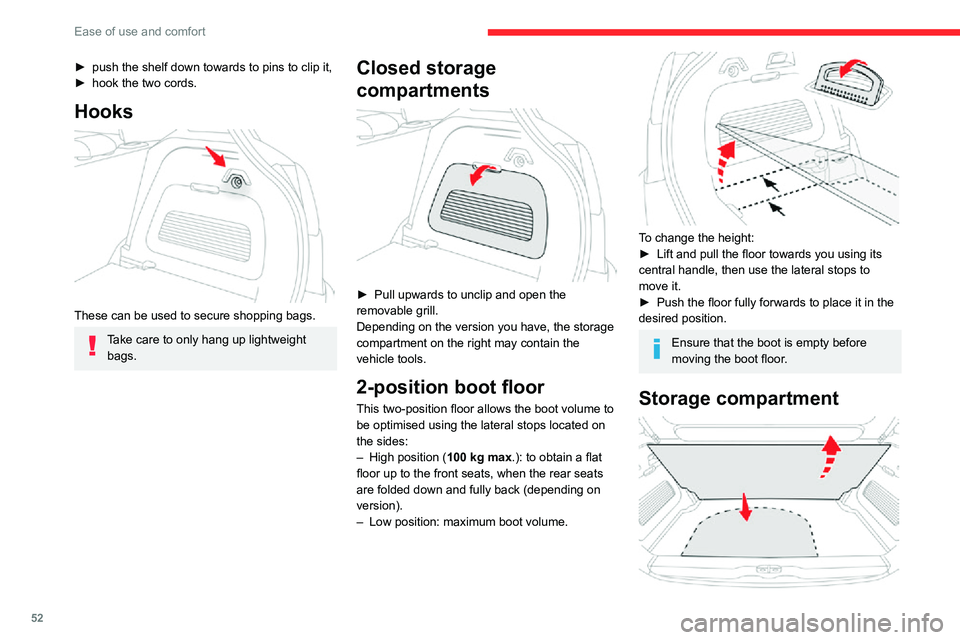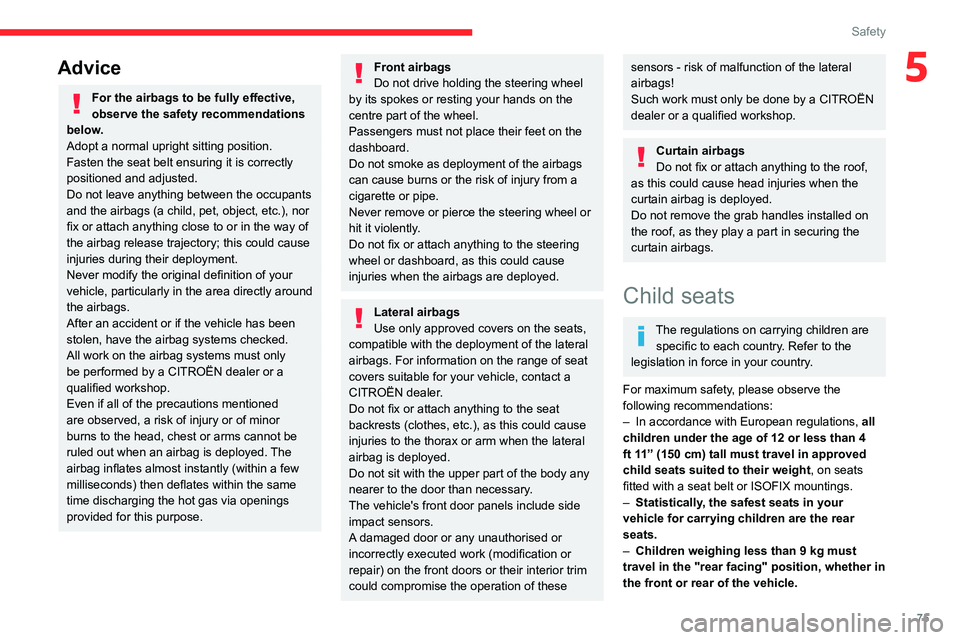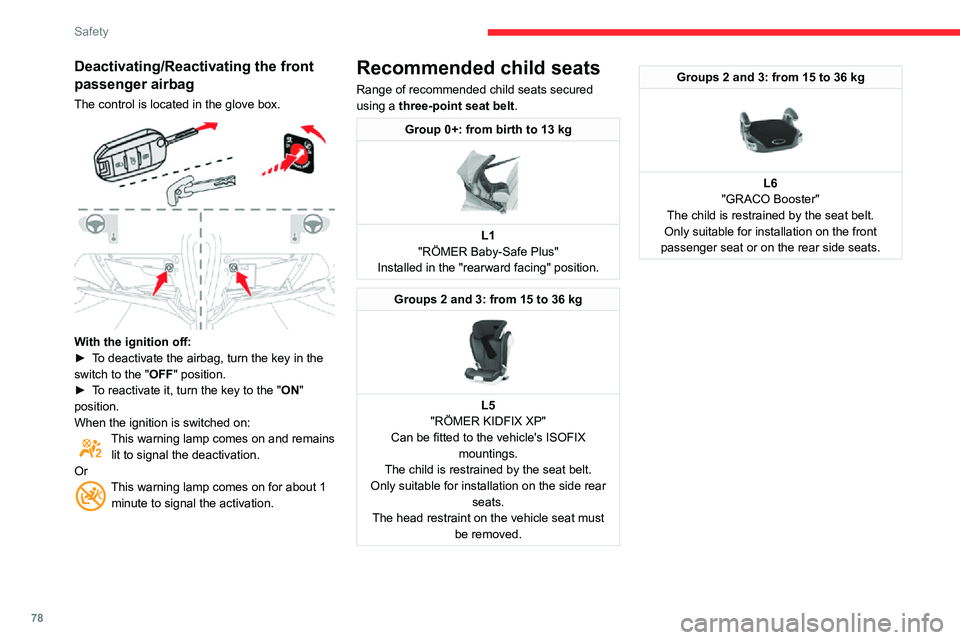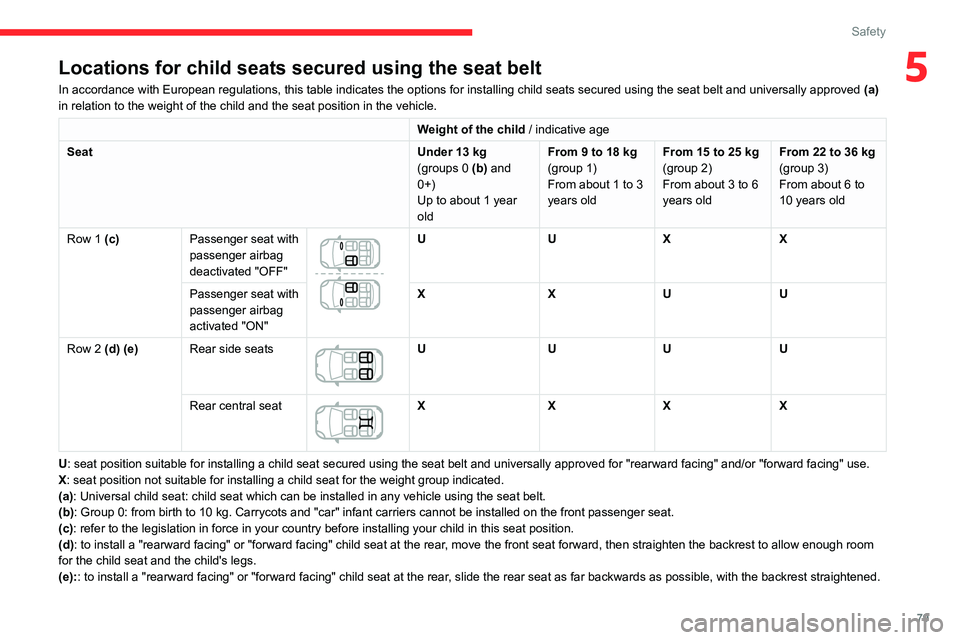weight CITROEN C3 AIRCROSS 2021 Handbook (in English)
[x] Cancel search | Manufacturer: CITROEN, Model Year: 2021, Model line: C3 AIRCROSS, Model: CITROEN C3 AIRCROSS 2021Pages: 244, PDF Size: 6.29 MB
Page 54 of 244

52
Ease of use and comfort
► push the shelf down towards to pins to clip it,► hook the two cords.
Hooks
These can be used to secure shopping bags.
Take care to only hang up lightweight
bags.
Closed storage
compartments
► Pull upwards to unclip and open the removable grill.
Depending on the version you have, the storage
compartment on the right may contain the
vehicle tools.
2-position boot floor
This two-position floor allows the boot volume to
be optimised using the lateral stops located on
the sides:
– High position (100 kg max .): to obtain a flat
floor up to the front seats, when the rear seats
are folded down and fully back (depending on
version).
– Low position: maximum boot volume.
To change the height:► Lift and pull the floor towards you using its central handle, then use the lateral stops to
move it.
► Push the floor fully forwards to place it in the desired position.
Ensure that the boot is empty before
moving the boot floor.
Storage compartment
► Raise the boot floor as much as possible to
access the storage well.
Depending on the version, it includes:
– a temporary puncture repair kit with the vehicle tools,– a single spare wheel with the vehicle tools.
Courtesy lamps
1. Front courtesy lamp
2. Front map reading lamps
3.Rear courtesy lamp
4. Rear map reading lamps
Page 77 of 244

75
Safety
5Advice
For the airbags to be fully effective,
observe the safety recommendations
below.
Adopt a normal upright sitting position.
Fasten the seat belt ensuring it is correctly
positioned and adjusted.
Do not leave anything between the occupants
and the airbags (a child, pet, object, etc.), nor
fix or attach anything close to or in the way of
the airbag release trajectory; this could cause
injuries during their deployment.
Never modify the original definition of your
vehicle, particularly in the area directly around
the airbags.
After an accident or if the vehicle has been
stolen, have the airbag systems checked.
All work on the airbag systems must only
be performed by a CITROËN dealer or a
qualified workshop.
Even if all of the precautions mentioned
are observed, a risk of injury or of minor
burns to the head, chest or arms cannot be
ruled out when an airbag is deployed. The
airbag inflates almost instantly (within a few
milliseconds) then deflates within the same
time discharging the hot gas via openings
provided for this purpose.
Front airbags
Do not drive holding the steering wheel
by its spokes or resting your hands on the
centre part of the wheel.
Passengers must not place their feet on the
dashboard.
Do not smoke as deployment of the airbags
can cause burns or the risk of injury from a
cigarette or pipe.
Never remove or pierce the steering wheel or
hit it violently.
Do not fix or attach anything to the steering
wheel or dashboard, as this could cause
injuries when the airbags are deployed.
Lateral airbags
Use only approved covers on the seats,
compatible with the deployment of the lateral
airbags. For information on the range of seat
covers suitable for your vehicle, contact a
CITROËN dealer.
Do not fix or attach anything to the seat
backrests (clothes, etc.), as this could cause
injuries to the thorax or arm when the lateral
airbag is deployed.
Do not sit with the upper part of the body any
nearer to the door than necessary.
The vehicle's front door panels include side
impact sensors.
A damaged door or any unauthorised or
incorrectly executed work (modification or
repair) on the front doors or their interior trim
could compromise the operation of these
sensors - risk of malfunction of the lateral
airbags!
Such work must only be done by a CITROËN
dealer or a qualified workshop.
Curtain airbags
Do not fix or attach anything to the roof,
as this could cause head injuries when the
curtain airbag is deployed.
Do not remove the grab handles installed on
the roof, as they play a part in securing the
curtain airbags.
Child seats
The regulations on carrying children are specific to each country. Refer to the
legislation in force in your country.
For maximum safety, please observe the
following recommendations:
– In accordance with European regulations, all
children under the age of 12 or less than 4
ft 11” (150 cm) tall must travel in approved
child seats suited to their weight , on seats
fitted with a seat belt or ISOFIX mountings.
– Statistically, the safest seats in your
vehicle for carrying children are the rear
seats.
– Children weighing less than 9 kg must
travel in the "rear facing" position, whether in
the front or rear of the vehicle.
Page 80 of 244

78
Safety
Deactivating/Reactivating the front
passenger airbag
The control is located in the glove box.
With the ignition off:► To deactivate the airbag, turn the key in the switch to the "OFF" position. ► To reactivate it, turn the key to the "ON"
position.
When the ignition is switched on:
This warning lamp comes on and remains lit to signal the deactivation.
Or
This warning lamp comes on for about 1 minute to signal the activation.
Recommended child seats
Range of recommended child seats secured
using a three-point seat belt.
Group 0+: from birth to 13 kg
L1
"RÖMER Baby-Safe Plus"
Installed in the "rearward facing" position.
Groups 2 and 3: from 15 to 36 kg
L5
"RÖMER KIDFIX XP"
Can be fitted to the vehicle's ISOFIX mountings.
The child is restrained by the seat belt.
Only suitable for installation on the side rear seats.
The head restraint on the vehicle seat must be removed.
Groups 2 and 3: from 15 to 36 kg
L6
"GRACO Booster"
The child is restrained by the seat belt.
Only suitable for installation on the front
passenger seat or on the rear side seats.
Locations for child seats secured using the seat belt
In accordance with European regulations, this table indicates the options for installing child seats secured using the seat belt and universally approved (a)
in relation to the weight of the child and the seat position in the vehicle.
Weight of the child
/ indicative age
SeatUnder 13 kg(groups 0 (b) and
0+)
Up to about 1 year
oldFrom 9 to 18 kg(group 1)
From about 1 to 3
years oldFrom 15 to 25 kg(group 2)
From about 3 to 6
years oldFrom 22 to 36 kg(group 3)
From about 6 to
10 years old
Row 1 (c) Passenger seat with
passenger airbag
deactivated "OFF"
U UX X
Passenger seat with
passenger airbag
activated "ON" X
XU U
Row 2 (d) (e) Rear side seats
U UU U
Rear central seat
X XX X
U
: seat position suitable for installing a child seat secured using the seat belt and universally approved for "rearward facing" and/or "forward facing" use.X: seat position not suitable for installing a child seat for the weight group indicated.
(a): Universal child seat: child seat which can be installed in any vehicle using the seat belt.
(b)
: Group 0: from birth to 10 kg. Carrycots and "car" infant carriers cannot be installed on the front passenger seat.(c): refer to the legislation in force in your country before installing your child in this seat position.
(d): to install a "rearward facing" or "forward facing" child seat at the rear , move the front seat forward, then straighten the backrest to allow enough room
for the child seat and the child's legs.
(e):: to install a "rearward facing" or "forward facing" child seat at the rear , slide the rear seat as far backwards as possible, with the backrest straightened.
Page 81 of 244

79
Safety
5Locations for child seats secured using the seat belt
In accordance with European regulations, this table indicates the options for installing child seats secured using the seat belt and universally approved (a)
in relation to the weight of the child and the seat position in the vehicle.
Weight of the child / indicative age
SeatUnder 13 kg(groups 0 (b) and
0+)
Up to about 1 year
oldFrom 9 to 18 kg(group 1)
From about 1 to 3
years oldFrom 15 to 25 kg(group 2)
From about 3 to 6
years oldFrom 22 to 36 kg(group 3)
From about 6 to
10 years old
Row 1 (c) Passenger seat with
passenger airbag
deactivated "OFF"
U UX X
Passenger seat with
passenger airbag
activated "ON" X
XU U
Row 2 (d) (e) Rear side seats
U UU U
Rear central seat
X XX X
U
: seat position suitable for installing a child seat secured using the seat belt and universally approved for "rearward facing" and/or "forward facing" use.X: seat position not suitable for installing a child seat for the weight group indicated.
(a): Universal child seat: child seat which can be installed in any vehicle using the seat belt.
(b)
: Group 0: from birth to 10 kg. Carrycots and "car" infant carriers cannot be installed on the front passenger seat.(c): refer to the legislation in force in your country before installing your child in this seat position.
(d): to install a "rearward facing" or "forward facing" child seat at the rear , move the front seat forward, then straighten the backrest to allow enough room
for the child seat and the child's legs.
(e):: to install a "rearward facing" or "forward facing" child seat at the rear , slide the rear seat as far backwards as possible, with the backrest straightened.
Page 82 of 244

80
Safety
“ISOFIX" mountings
The seats shown below are fitted with ISOFIX
compliant mountings:
The mountings comprise three rings for each
seat, indicated by a marking:
– Two rings A, located between the vehicle seat
backrest and cushion.
The 2 latches of ISOFIX child seats are secured
to them.
– One ring B, located behind the seat, called
the TOP TETHER, for fixing seats fitted with an
upper strap.
This system prevents the child seat from tipping
forward in the event of a front impact.
This ISOFIX mounting system provides fast,
reliable and safe fitting of the child seat in the
vehicle.
To secure the child seat to the TOP TETHER:
► Remove and stow the head restraint before
installing the child seat on this seat (refit it once
the child seat has been removed).
► Pass the upper strap of the child seat behind the seat backrest, between the head restraint
rods.
► Secure the upper strap hook to ring B.► Tighten the upper strap.
When fitting an ISOFIX child seat to the
left-hand rear seat of the bench seat,
before fitting the seat, first move the centre
rear seat belt towards the middle of the
vehicle, so as to avoid the seat interfering
with the operation of the seat belt.
An incorrectly installed child seat compromises the child's safety in the
event of an accident.
Strictly observe the fitting instructions
provided in the user guide supplied with the
child seat.
For information about the installation
possibilities for ISOFIX child seats in
your vehicle, refer to the summary table.
Recommended ISOFIX child
seats
Also consult the user guide from the child seat’s manufacturer to find out how to
install and remove the seat.
Summary table of locations for ISOFIX child seats
In accordance with European regulations, this table shows the options for installing ISOFIX child seats on vehicle seats fitted with ISOFIX mountings.
In the case of universal and semi-universal ISOFIX child seats, the ISOFIX size category , determined by a letter from A to G, is indicated on the child seat
next to the ISOFIX logo.
Weight of the child
/ indicative age
Under 10 kg(group 0)Up to about 6 months old
Under 10 kg(group 0)Under 13 kg (group 0+)Up to about 1 year old
From 9 to 18 kg(group 1)
From about 1 to 3 years old
Type of ISOFIX child seat CarrycotRearward facing Rearward
facing Forward facing
Page 83 of 244

81
Safety
5"RÖMER Baby-Safe Plus and its ISOFIX base"
(size category: E)
Group 0+: from birth to 13 kg
Installed "rearward facing" using an ISOFIX base which is attached to rings A.
The base has a support leg, height-
adjustable, which rests on the vehicle's floor. This child seat can also be secured with a
seat belt. In this case, only the shell is used and attached to the vehicle seat using the three-point seat belt.
"RÖMER Duo Plus ISOFIX "
(size category: B1)
Group 1: from 9 to 18 kg
"RÖMER Duo Plus ISOFIX "
(size category: B1)
Group 1: from 9 to 18 kg
Suitable for forward-facing installation only.
Attached to rings A and ring B, referred to as
TOP TETHER, using an upper strap.
Three seat body angles: sitting, reclining, lying down.
This child seat can also be used in seat positions not equipped with ISOFIX
mountings. In this case, it must be secured to the vehicle's seat by the three-point seat belt. Adjust the front seat of the vehicle so that the child's feet do not touch the backrest.
Summary table of locations for ISOFIX child seats
In accordance with European regulations, this table shows the options for installing ISOFIX child seats on vehicle seats fitted with ISOFIX mountings.
In the case of universal and semi-universal ISOFIX child seats, the ISOFIX size category , determined by a letter from A to G, is indicated on the child seat
next to the ISOFIX logo.
Weight of the child / indicative age
Under 10 kg(group 0)Up to about 6 months old
Under 10 kg(group 0)Under 13 kg (group 0+)Up to about 1 year old
From 9 to 18 kg(group 1)
From about 1 to 3 years old
Type of ISOFIX child seat CarrycotRearward facing Rearward
facing Forward facing
Page 84 of 244

82
Safety
Weight of the child / indicative age
Under 10 kg(group 0)Up to about 6 months old
Under 10 kg(group 0)Under 13 kg (group 0+)Up to about 1 year old
From 9 to 18 kg(group 1)
From about 1 to 3 years old
ISOFIX size category FG CD EC DABB1
Seat
Row 1 (a) Passenger seat
Front
passenger airbag
deactivated "OFF " Not ISOFIX
Front
passenger airbag
activated "ON" Not ISOFIX
Row 2 (b)
Rear side seats
X IL ILIUF / IL
Rear central seat
Not ISOFIX
(a): refer to the legislation in force in your country before installing a child in this seat position.
(b): to install a “rearward facing” or “forward facing” child seat at the rear , slide the rear seat as far backwards as possible, with the backrest straightened.
IUF: seat position suitable for installing an Isofix Universal seat, "Forward facing", secured using the upper strap.
IL: seat position suitable for installing an Isofix Semi-Universal seat, either:– "rearward facing" fitted with an upper strap or a support leg.– “forward facing”, fitted with a support leg.– a carrycot fitted with an upper strap or a support leg.For securing the upper strap using the ISOFIX mountings, refer to the corresponding section.
X: seat position not suitable for installing an ISOFIX seat or carrycot for the weight group indicated.
i-Size child seats
i-Size child seats have two latches that engage on the two rings A.
These i-Size child seats also have:
– either an upper strap that is attached to ring B.– or a support leg that rests on the vehicle floor, compatible with the approved i-Size seat position.Their role is to prevent the child seat from tipping forward in the event of a collision.
For more information on the ISOFIX mountings, refer to the corresponding section.
In accordance with the new European regulations, this table indicates the options for installing i-Size child seats on seats in the vehicle fitted with ISOFIX
mountings approved for i-Size.
Seat i-Size restraint system
Row 1 (a) Passenger seat with passenger
airbag deactivated "OFF"
Not i-Size
Passenger seat with passenger
airbag activated "ON" Not i-Size
Row 2 (b)
Rear side seats
i-U
Rear central seat
Not i-Size
i-U: suitable for i-Size restraint systems in the "Universal" category , "forward facing" and "rearward facing".
Page 85 of 244

83
Safety
5IL: seat position suitable for installing an Isofix Semi-Universal seat, either:– "rearward facing" fitted with an upper strap or a support leg.– “forward facing”, fitted with a support leg.– a carrycot fitted with an upper strap or a support leg.For securing the upper strap using the ISOFIX mountings, refer to the corresponding section.
X: seat position not suitable for installing an ISOFIX seat or carrycot for the weight group indicated.
i-Size child seats
i-Size child seats have two latches that engage on the two rings A.
These i-Size child seats also have:
– either an upper strap that is attached to ring B.– or a support leg that rests on the vehicle floor , compatible with the approved i-Size seat position.Their role is to prevent the child seat from tipping forward in the event of a collision.
For more information on the ISOFIX mountings, refer to the corresponding section.
In accordance with the new European regulations, this table indicates the options for installing i-Size child seats on seats in the vehicle fitted with ISOFIX
mountings approved for i-Size.
Seat i-Size restraint system
Row 1 (a) Passenger seat with passenger
airbag deactivated "OFF"
Not i-Size
Passenger seat with passenger
airbag activated "ON" Not i-Size
Row 2 (b)
Rear side seats
i-U
Rear central seat
Not i-Size
i-U: suitable for i-Size restraint systems in the "Universal" category , "forward facing" and "rearward facing".
Page 88 of 244

86
Driving
Driving recommendations
► Observe the driving regulations and remain vigilant whatever the traffic conditions.► Monitor your environment and keep your hands on the wheel to be able to react to
anything that may happen any time.
► Drive smoothly, anticipate the need for braking and maintain a longer safety distance,
especially in bad weather.
► Stop the vehicle to carry out operations that require close attention (such as adjustments).► During long trips, take a break every two hours.
Important!
Never leave the engine running in a
closed space without sufficient
ventilation. Internal combustion engines emit
toxic exhaust gases such as carbon
monoxide. Danger of poisoning and death!
In severe wintry conditions (temperature
below -23°C), let the engine run for 4
minutes before moving off, to ensure the
correct operation and durability of the
mechanical components of your vehicle
(engine and gearbox).
Never drive with the parking brake
applied . Risk of overheating and
damage to the braking system!
Do not park the vehicle or leave the
engine running on a flammable
surface (dry grass, dead leaves, etc.). The
exhaust system of your vehicle is very hot,
even several minutes after the engine stops.
Risk of fire!
Never leave a vehicle unattended with
the engine running. If you have to leave
your vehicle with the engine running, apply
the parking brake and put the gearbox into
neutral or position N or P (depending on the
type of gearbox).
Never leave children inside the vehicle
unsupervised.
On flooded roads
We strongly advise against driving on flooded
roads, as this could cause serious damage to
the engine or gearbox, as well as to the electrical
systems of your vehicle.
If you are obliged to drive on a flooded road:
► check that the depth of water does not exceed 15 cm, taking account of waves that might be generated by other users,► deactivate the Stop & Start function,► drive as slowly as possible without stalling. In all cases, do not exceed 6 mph (10 km/h),► do not stop and do not switch off the engine.On leaving the flooded road, as soon as safety
conditions allow, make several light brake
applications to dry the brake discs and pads.
If in doubt about the state of your vehicle,
contact a CITROËN dealer or a qualified
workshop.
In case of towing
Driving with a trailer places greater
demands on the towing vehicle and
requires extra care from the driver.
Respect the maximum towable weights.
At altitude: reduce the maximum load by
10% per 1,000 metres of altitude; the density
of the air decreases with altitude and the
performance of the engine reduces.
New vehicle: do not pull a trailer before
having driven at least 620 miles (1,000
kilometres).
If the outside temperature is high, let the
engine idle for 1 to 2 minutes after the
vehicle comes to a stop, to help it to cool.
Before setting off
Nose weight
► Distribute the load in the trailer so that the heaviest items are as close as possible to the
axle and the nose weight (at the point where it
joins your vehicle) approaches the maximum
permitted without exceeding it.
Tyres
► Check the tyre pressures of the towing vehicle and of the trailer, observing the
recommended pressures.
Lighting
► Check the electrical signalling on the trailer and the headlamp beam height of your vehicle.
If a genuine CITROËN towing device is
used, the rear parking sensors will be
deactivated automatically to avoid the audible
signal.
When driving
Cooling
Towing a trailer uphill causes the coolant
temperature to increase. The maximum towable
load depends on the gradient and the exterior
temperature. The fan’s cooling capacity does not
increase with engine speed.
► Reduce speed and lower the engine speed to limit heating up.
Page 89 of 244

87
Driving
6Before setting off
Nose weight
► Distribute the load in the trailer so that the heaviest items are as close as possible to the
axle and the nose weight (at the point where it
joins your vehicle) approaches the maximum
permitted without exceeding it.
Tyres
► Check the tyre pressures of the towing vehicle and of the trailer, observing the
recommended pressures.
Lighting
► Check the electrical signalling on the trailer and the headlamp beam height of your vehicle.
If a genuine CITROËN towing device is
used, the rear parking sensors will be
deactivated automatically to avoid the audible
signal.
When driving
Cooling
Towing a trailer uphill causes the coolant
temperature to increase. The maximum towable
load depends on the gradient and the exterior
temperature. The fan’s cooling capacity does not
increase with engine speed.
► Reduce speed and lower the engine speed to limit heating up.
In all cases, pay attention to the coolant
temperature.
If this warning lamp and the STOP
warning lamp come on, stop the vehicle
and switch off the engine as soon as possible.
Brakes
Braking distances are increased when towing a
trailer. To avoid overheating the brakes, the use
of engine braking is recommended.
Side wind
Bear in mind that the vehicle will be more
susceptible to wind when towing.
Anti-theft protection
Electronic immobiliser
The keys include an electronic engine
immobiliser system, whose secret code must be
recognised in order for starting to be possible.
If the system malfunctions, indicated by the
display of a message, the engine will not start.
Contact a CITROËN dealer.
For safety and theft protection reasons,
do not leave your electronic key in the
vehicle, even when you are close to it.
It is recommended that you keep it with you.
Starting / Switching off the
engine with the key
Key ignition switch
It has 3 positions:– 1. Stop : inserting and removing the key,
steering column locked.
– 2. Ignition : steering column unlocked, ignition
on, Diesel preheating, engine running.
– 3. Starting.
Avoid attaching heavy objects to the key or the remote control. It would weigh
down on its shaft in the ignition switch and
could cause a malfunction.
Ignition on position
It allows the use of the vehicle's electric
equipment or portable devices to be charged.
Once the state of charge of the battery drops to
the reserve level, the system switches to energy
economy mode : the power supply is cut off